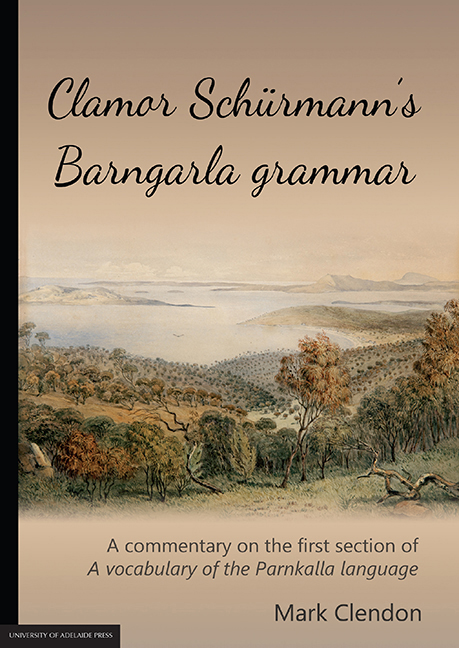 Clamor Schürmann's Barngarla grammar
Clamor Schürmann's Barngarla grammar Book contents
- Frontmatter
- Frontispiece
- Contents
- Abbreviations used in glossing sentence examples & in the text
- Preface
- Map: The northern and western Thura-Yura languages
- 1 Introduction
- 2 Writing Barngarla sounds
- 3 Pronouns
- 4 Intransitive verbs
- 5 Transitive verbs
- 6 Harry Crawford's Barngarla verbs
- 7 Suffixes on nouns
- 8 Other suffixes
- 9 Demonstrative & interrogative pronouns
- 10 Verbal derivational affixes
- 11 Non-finite verbs
- 12 Putting words together
- 13 Prospect
- Appendix The name Barngarla
- References
12 - Putting words together
Published online by Cambridge University Press: 05 February 2016
- Frontmatter
- Frontispiece
- Contents
- Abbreviations used in glossing sentence examples & in the text
- Preface
- Map: The northern and western Thura-Yura languages
- 1 Introduction
- 2 Writing Barngarla sounds
- 3 Pronouns
- 4 Intransitive verbs
- 5 Transitive verbs
- 6 Harry Crawford's Barngarla verbs
- 7 Suffixes on nouns
- 8 Other suffixes
- 9 Demonstrative & interrogative pronouns
- 10 Verbal derivational affixes
- 11 Non-finite verbs
- 12 Putting words together
- 13 Prospect
- Appendix The name Barngarla
- References
Summary
So far we have been able to observe some of Barngarla's basic morphology, but there is more to language than morphology. The grammar of a language includes most importantly the network of abstract relations that hold between words, which enable them to be assembled into meaningful sequences of sounds. To some extent we have been able to see how some of these networks operate in Barngarla; we have seen how words may be turned into verbs, how verbs may be made intransitive or transitive, how nouns and pronouns code for who is doing what to whom, and how things may be described one in relation to another.
Nineteenth-century linguistics was interested mainly in morphology, as this was the most impressive feature of Latin, Sanskrit and Homeric Greek, which were studied as exemplars of linguistic elaboration and sophistication par excellence. It was not until the late nineteenth century that linguists began to look seriously beyond morphology at the systems of dependencies that constitute syntax.
Nevertheless, Schürmann's vocabulary offers us examples of Barngarla sentences from which we are able to glimpse some of the syntactic relationships that hold between the different parts of utterances. A few of these phenomena will be surveyed here, not as an exhaustive account of what Schürmann has left us, but rather as a suggestion of what else we may yet be able to discover.
Using pronouns
Pronouns in Thura-Yura languages were not used nearly as frequently as they are in English (see Hercus 1999: 71 for Wirangu). As in many languages, Barngarla people probably gathered who was doing what to whom most of the time from context: that is, from what was happening around them, or from what people had just been talking about. So five-syllable pronouns like budlanbidningi ‘with them two’ and yardnagudnirhu ‘to them’ were probably used only when there was ambiguity, and in order to make someone's meaning clear; and this may not have been very often. Likewise, pronouns were used quite differently from the way we use pronouns. So in English we would normally say, go with him, using the third person singular pronoun him.
- Type
- Chapter
- Information
- Clamor Schürmann's Barngarla grammarA commentary on the first section of A vocabulary of the Parnkalla language, pp. 159 - 170Publisher: The University of Adelaide PressPrint publication year: 2015
